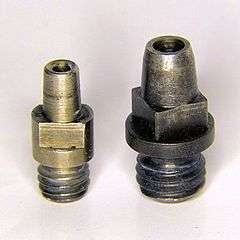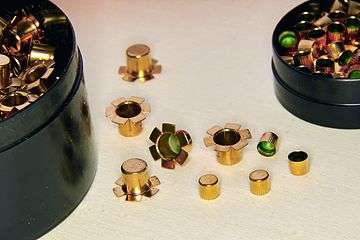Percussion rifle
The percussion rifle is a rifle that uses a percussion cap instead of older flintlock or matchlock variants. Faster reloading and fewer moving parts made this rifle more versatile and rugged compared to other single-shot rifles. The other advantage was that percussion caps were more reliable in bad weather, flintlocks and or matchlocks rifles did not work well in rain.[1][2]
The U.S. adopted the percussion system in 1841 and produced the M1841 Mississippi rifle that same year, made by Harpers Ferry Armory, E. Whitney. This was a .54 caliber, 33-inch-barrel percussion rifle. The new arm was very popular, since it was accurate and easy to handle, and its browned barrel finish contrasting with the bright brass furniture gave it a pleasing appearance. It won fame in the Mexican-American War with Jefferson Davis’ regiment of Mississippi riflemen at the battle of Buena Vista, and its continuing popularity was such that most Confederate rifle manufacturers later copied its overall style. Some were later converted to .58 caliber and fitted with long-range rear sights, but those used at Mill Springs seem to have been the original .54 caliber variety, which had simple notch rear sights. Many early percussion rifles were converted flintlock muskets. Percussion rifles were not made for very long, as percussion rifles were replaced in the 1860s by breechloading rifles, like trapdoor Springfields and the Snider-Enfield. The Dreyse needle gun that used a firing pin, not a percussion cap, showed that rate of fire of breechloading firing pin rifles was much higher.[3][4][5][6]





Notable Percussion rifles
The notable percussion rifles/muskets include:
- Brown Bess few Converted - UK 1840s
- Brunswick Rifle UK - 1836–1885
- Small number of converted Charleville musket - French - 1717-1840
- Infanteriegewehr Modell 1842 Swiss
- Joslyn rifle US - 1855–1865
- Lorenz rifle - Austrian - 1854
- M1819 Hall rifle one of the first percussion lock rifle - US - 1820–1830
- M1841 Mississippi Rifle - US - 1840 - Harpers Ferry Armory, E. Whitney
- Minié rifle - French
- Model 1795 Musket- a few converted - 1795 a Springfield rifle
- Model 1816 Musket - a few converted - 1816 a Springfield
- Model 1822 Musket - a few converted - 1822 a Springfield
- Springfield Model 1842 - first non-converted percussion lock musket
- Fayetteville rifle - Confederate States - 1862–1865
- Richmond Rifle - Confederate States - 1861
- Pattern 1853 Enfield - Uk - 1853–1889
- Sharps rifle breechloading - US - 1848
- Springfield Model 1861
- Springfield Model 1863
- Vereinsgewehr 1857 - German - 1861-1868
- Whitworth rifle - UK - 1854-1857
See also
- Cap gun
- Caplock mechanism
- Internal ballistics
- Tubes and primers for ammunition
- Minié ball
- Gunpowder
- Muzzleloader
- Muzzle (firearms)
- Rifling
- smoothbore
- Gun barrel
- Projectile
References
- ↑ Fadala, Sam (17 November 2006). The Complete Blackpowder Handbook. Iola, Wisconsin: Gun Digest Books. pp. 159–161. ISBN 0-89689-390-1.
- ↑
- Winant, L. (1956). Early percussion firearms. Bonanza Books
- ↑ civilwar.si.edu, Smithsonian, 1861 percussion rifle
- ↑ armscollectors.com, Important Dates in Gun History, (Based on A History of Firearms by Major H.B.C. Pollard)
- ↑ globalsecurity.org, Rifle History
- ↑ thearmsguide.com, How Do Caplock [Percussion] Firearms Work?, May 29th, 2014, by Mark3smle